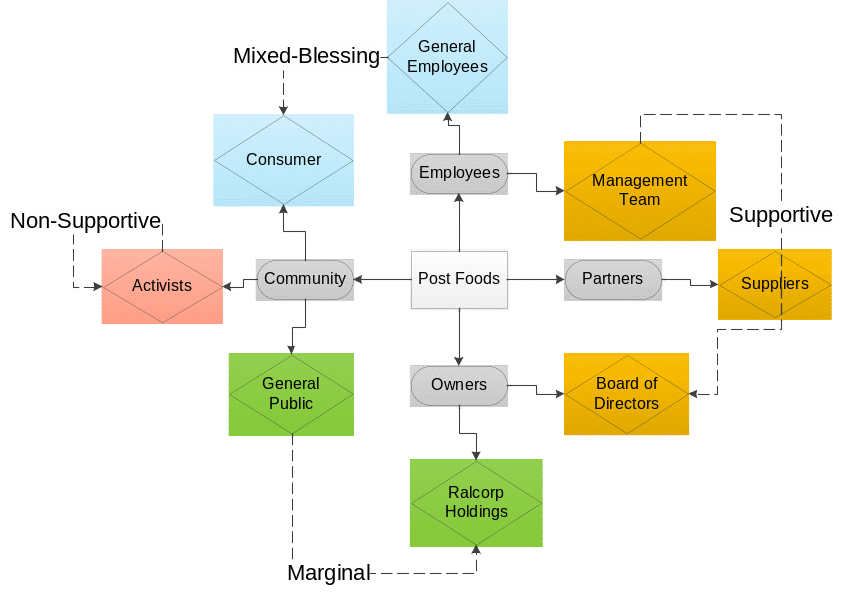Post Foods stakeholder structure has been analyzed in order to identify the key stakeholder groups. Upon the analysis, a series of stakeholders was defined:
- Board of Directors
- This group comprises eight directors: William P. Stiritz, Jay W. Brown, Gregory L. Curl, David W. Kemper, Robert V. Vitale, Edwin H. Callison, Robert E. Grote, and David P. Skarie (Post, 2016).
- Management Team
- This group is composed of CEOs and VPs: Robert V. Vitale, Diedre J. Gray, Christopher J. Neugent, James E. Dwyer, Jr. Richard, R. Koulouris, and Jeff A. Zadoks (Post, 2016).
- Consumers
- This group comprises all the consumers that buy the products offered by one of the Post Foods sub-brands.
- Ralcorp Holdings
- Ralcorp Holdings are included in the shareholder list as they own 80% of the Post Foods stock (Post Foods on Its Own, 2012).
- Suppliers
- This group mainly comprises the farming community that might be affected by the scandal (Strom, 2016).
- Employees
- This group includes all the employees that work for Post Foods worldwide and in the USA, in particular.
- Community
- The community group comprises civil groups and environmental activists.
The table below illustrates the stakeholders’ stakes.
Table 1. “Stake Identification”.
Summarizing the stakeholders’ interests, all the stakeholders can be divided into four groups:
- Finance-related stake: Board of Directors, Ralcorp Holdings, suppliers.
- Work-related stake: management team, employees, and suppliers.
- Health-related stake: consumers.
- Social change interest: community.
In the framework of the analysis, each stakeholder has been assigned a special status. The most legitimate stakeholders are highlighted green, the most urgent stakeholders – yellow, and the most powerful – blue.
Hence, it is considered that the most legitimate stakeholders are employees and the management team. According to Capon (2008), these stakeholders demonstrate conduct that is “right, and conforms to expected and acceptable standards” (p. 144). Otherwise stated, these two groups are most likely to perform the actions that meet the interests of Post Foods.
Community and consumers are defined as the most urgent stakeholders. Therefore, it is assumed that Capon (2008) notes that such stakeholders and their needs demand a “time-sensitive” attitude (p. 144). Post Foods should address their problems first of all. Otherwise, consumers can change their behavior and turn to the company’s rivals provoking a rapid sales fall. Communities, in their turn, might further develop the scandal affecting the company’s image negatively.
The Board of Directors and Ralcorp Holdings are considered to compose the most powerful group. Capon (2008) describes this group as the one that possesses enough power and resources to “bring the outcomes they desire” (p. 144). Hence, the decision made by these groups is likely to have a diverse impact on all other stakeholders: employees, suppliers, community, customers, and management team.
In the framework of the analysis, all the stakeholders were divided into four groups: supportive, non-supportive, marginal, and mixed-blessing.
The supportive group is represented by the management team, suppliers and the Board of Directors. These stakeholders are most likely to have a high cooperative potential. The marginal group comprises general public and Ralcorp Holdings. These stakeholders are assumed to be relatively indifferent to the company’s performance. General employees and consumers compose the mixed-blessing group as their supportiveness depends on the strategy that the corporate governance adopts. Finally, the non-supportive group includes activists as they possess a high threat potential after the discussed incident (Carroll & Buchhotz, 2014). The visual analysis of the stakeholders’ groups is represented below.

Reference List
Capon, C. (2008). Understanding strategic management. Harlow, Essex: Pearson Education.
Carroll, A. B., & Buchhotz, A.K. (2014). Business and society: ethics, sustainability, and stakeholder management. New York, New York: Cengage Learning.
Post. (2016). Leadership. Web.
Post Foods on Its Own. (2012). Web.
Strom, S. (2016). Quaker Oats’ 100% natural claim questioned in lawsuit, The New York Times. Web.
Watson, E. (2016). Post Foods targeted in latest ‘100% natural’ lawsuit over glyphosate, Food Navigator. Web.